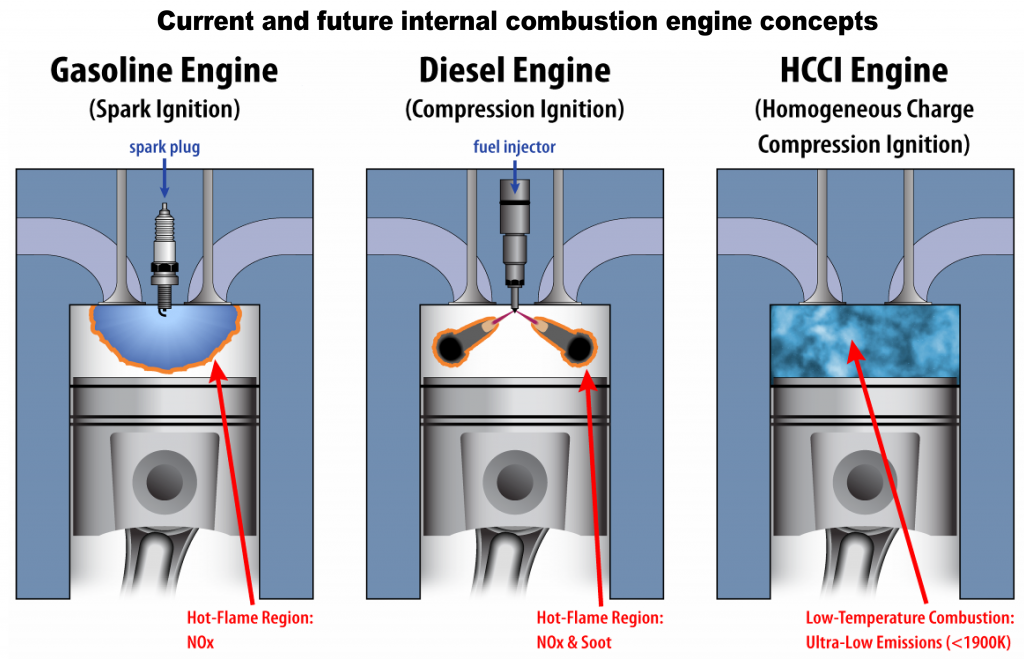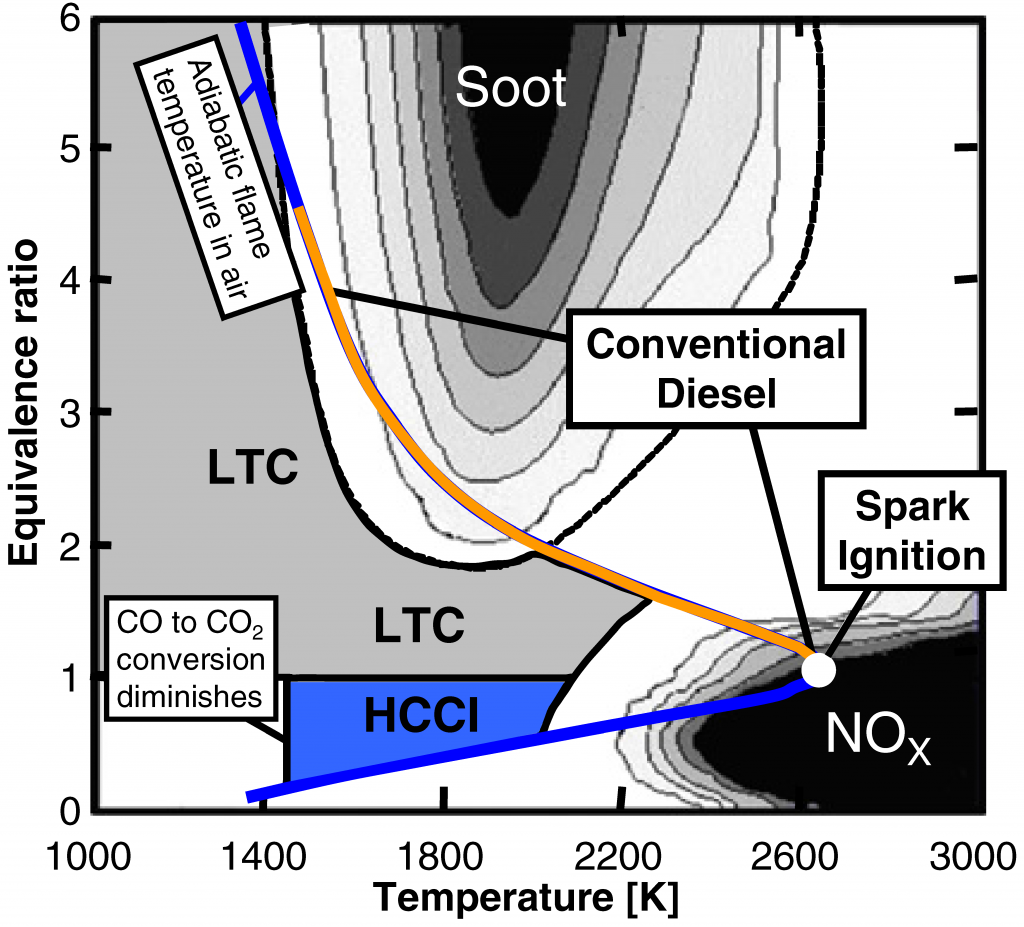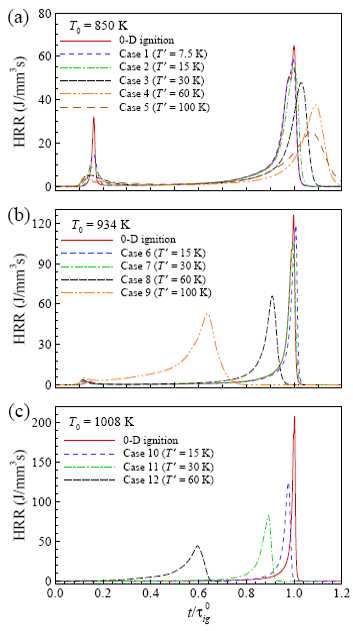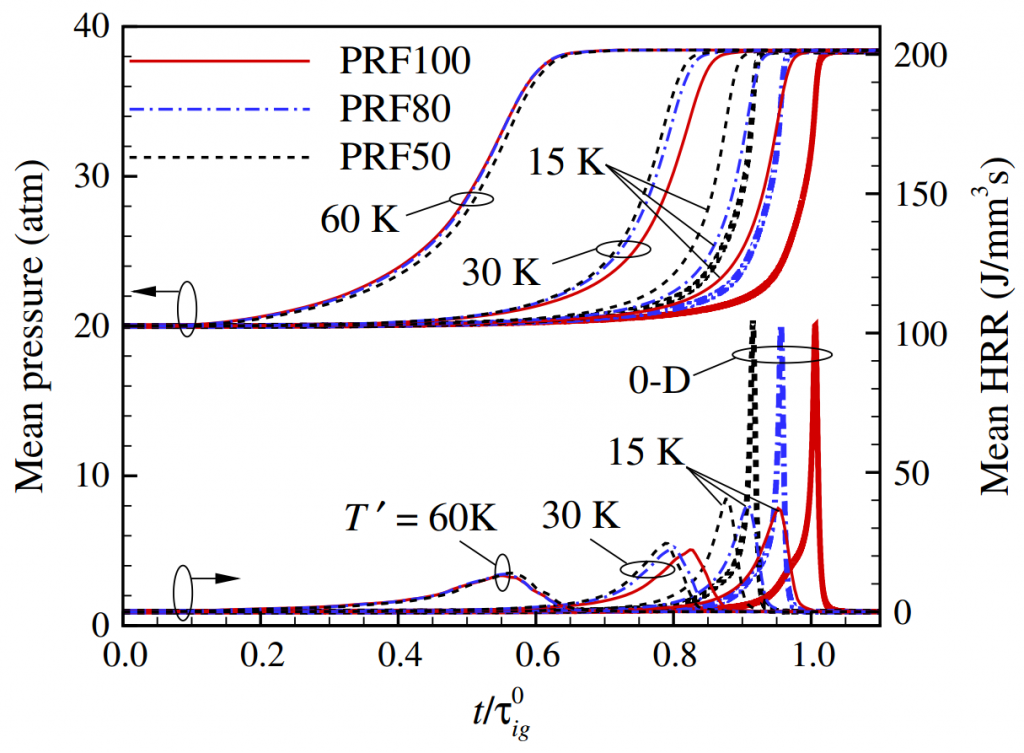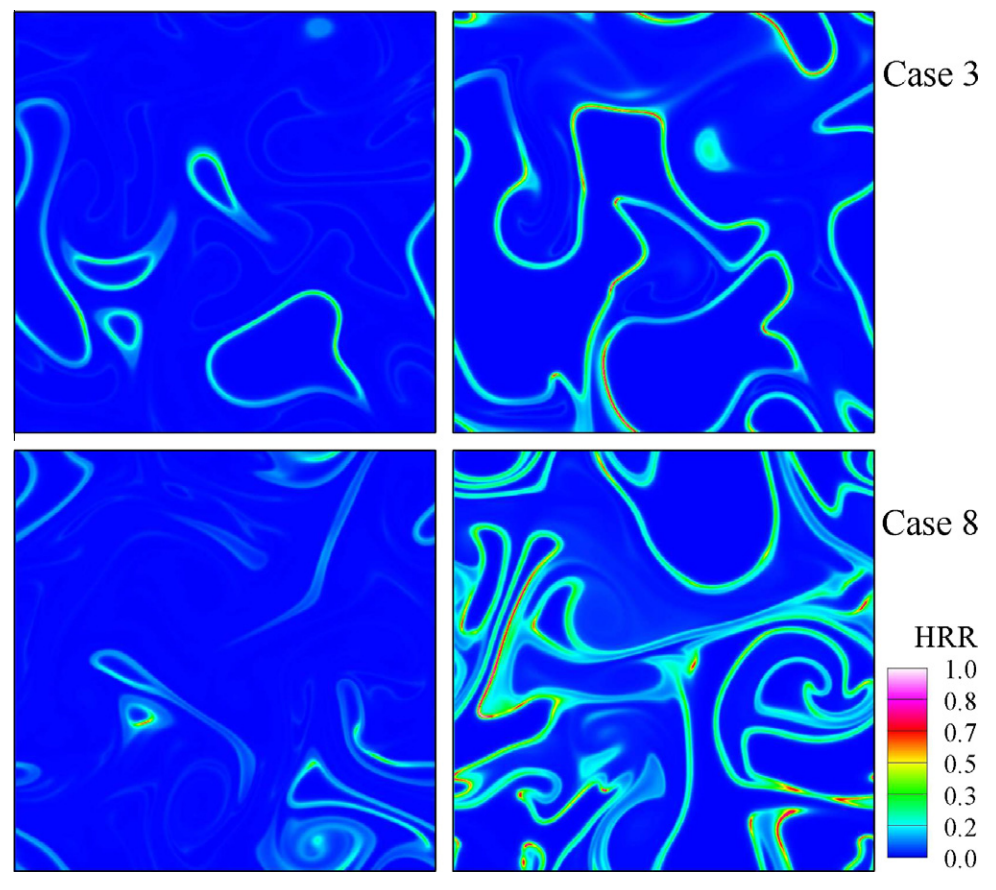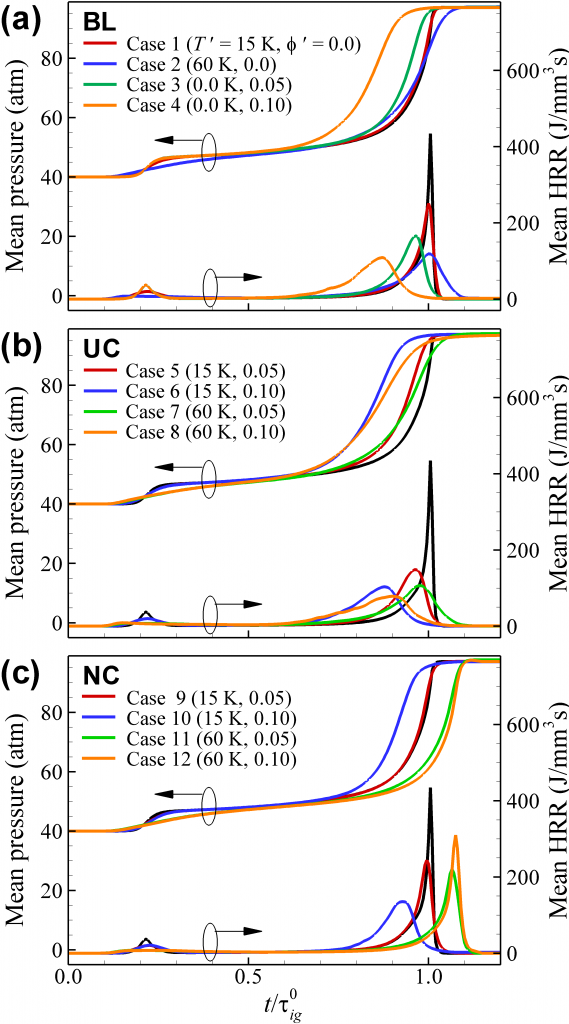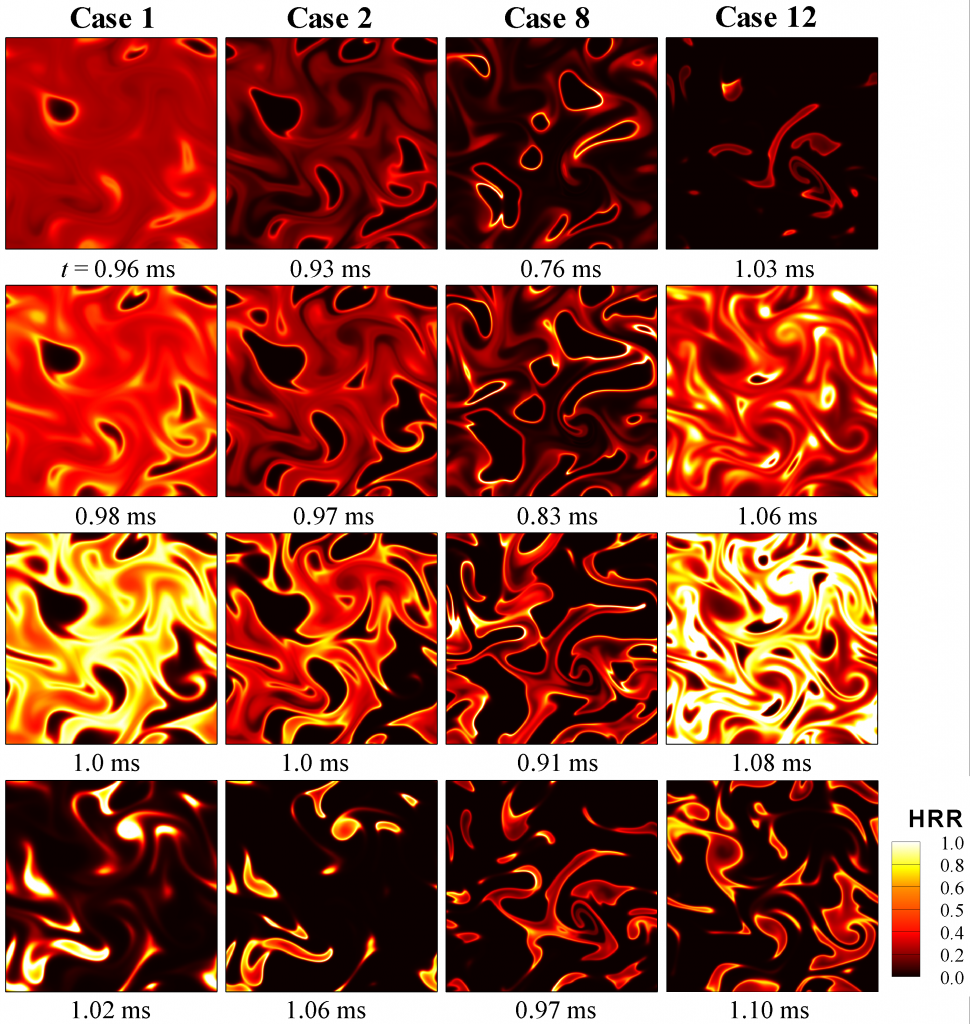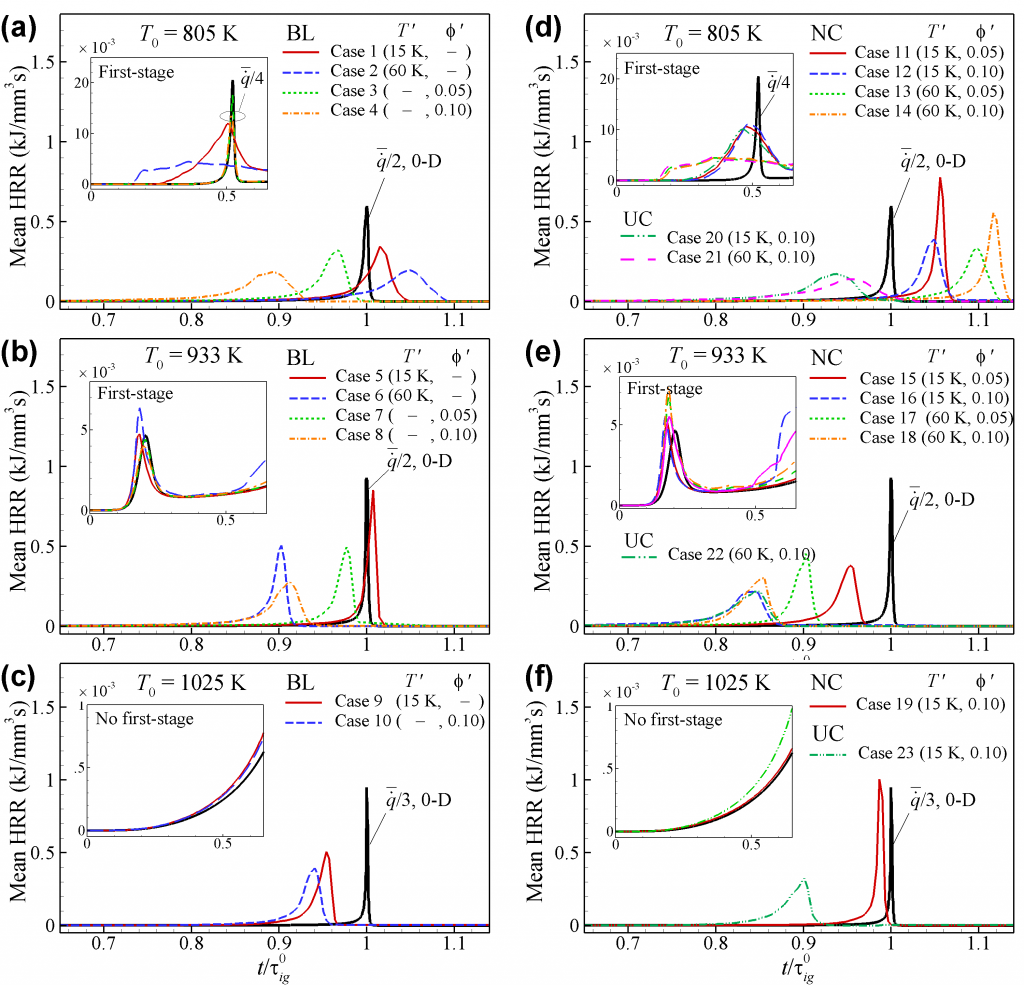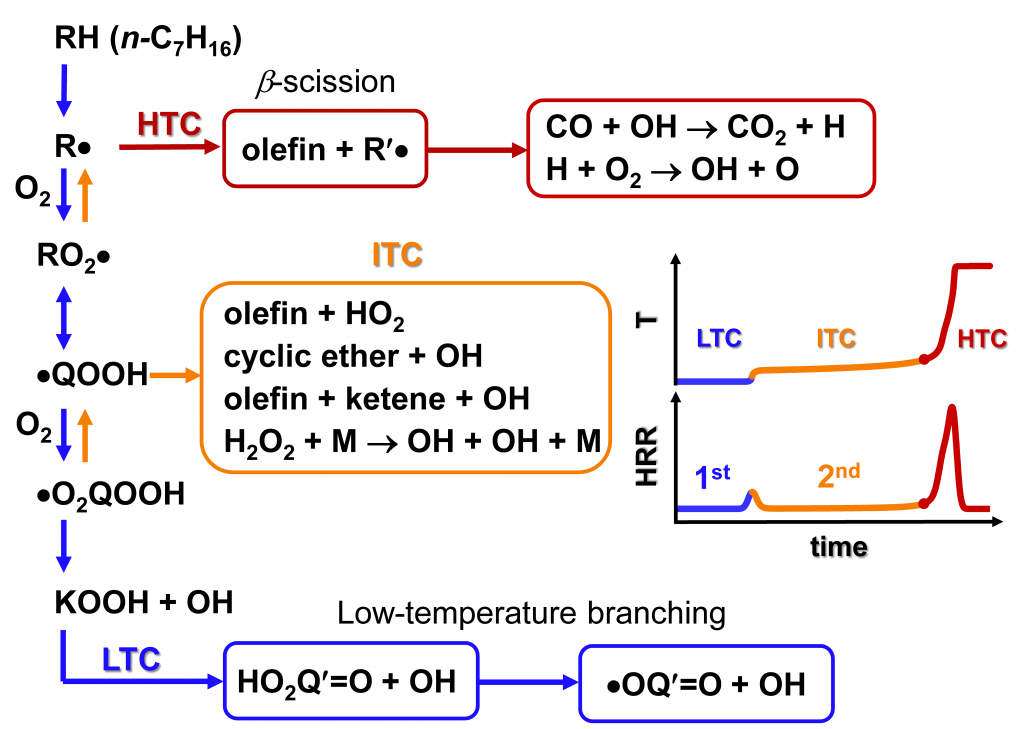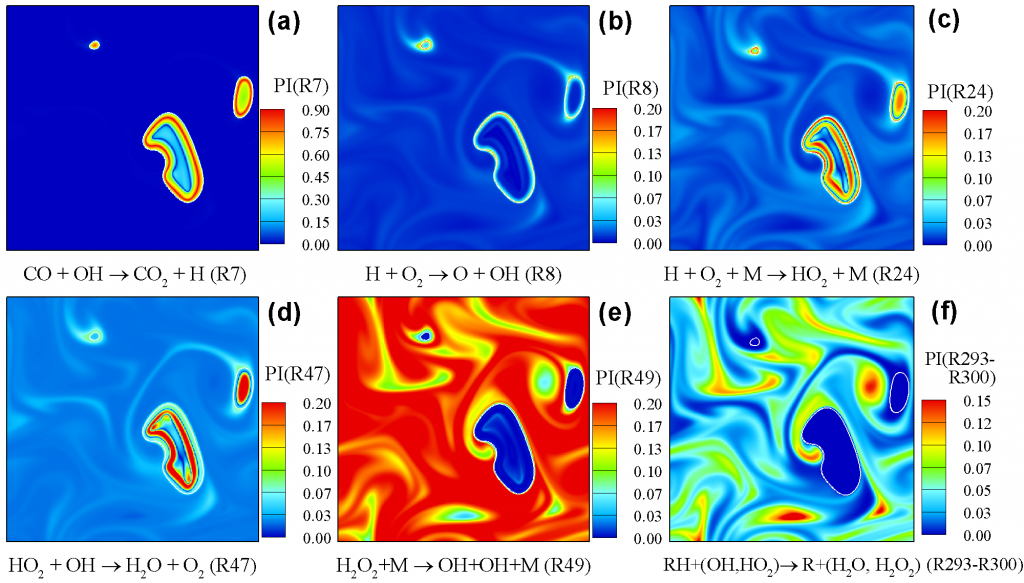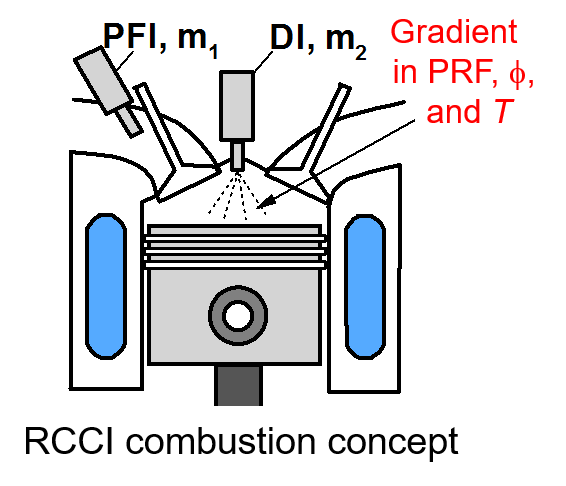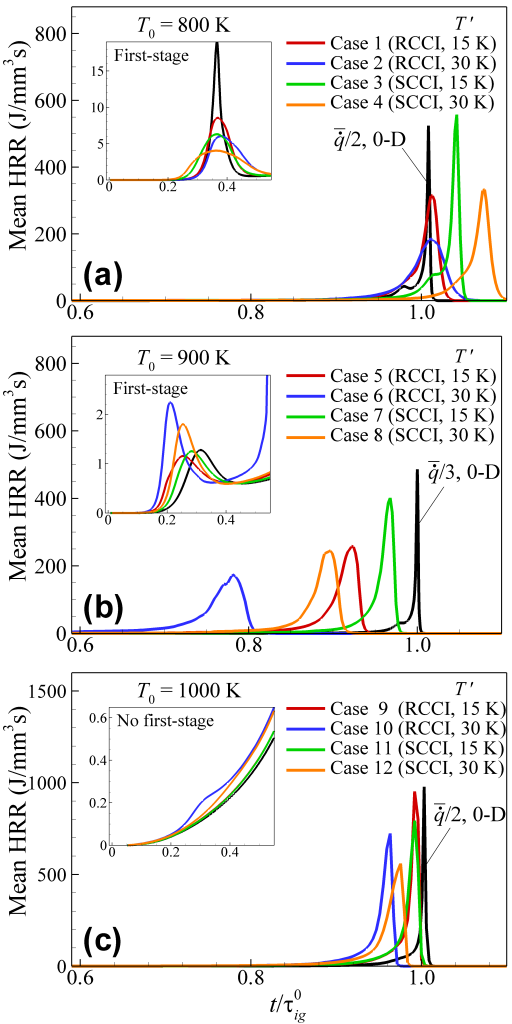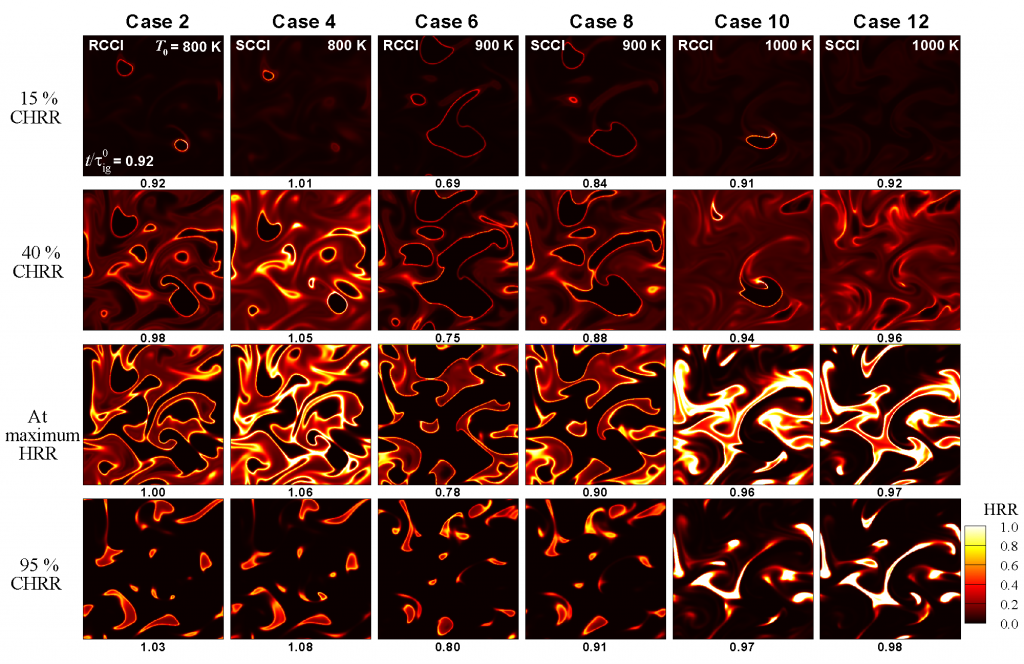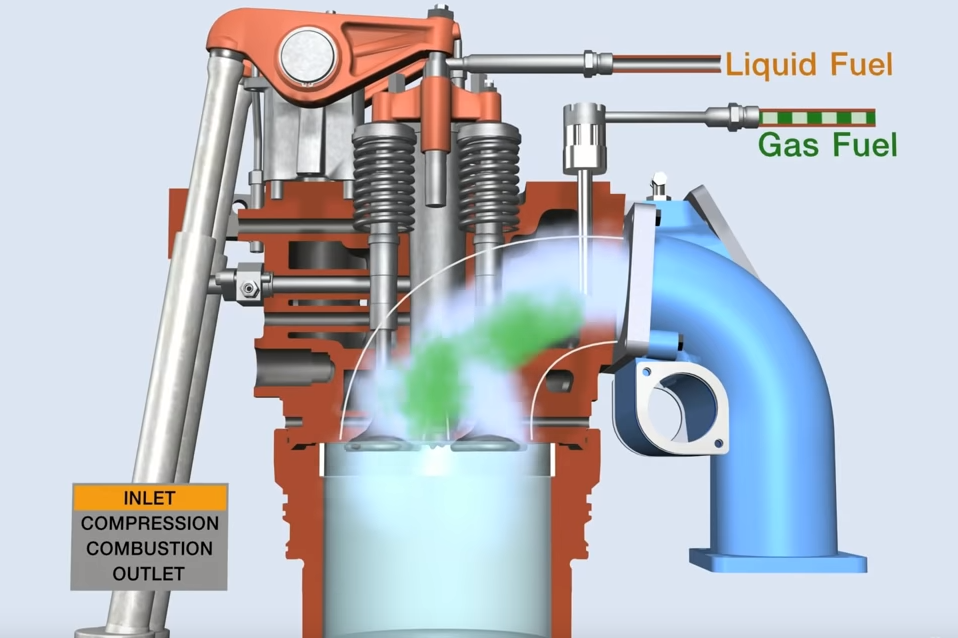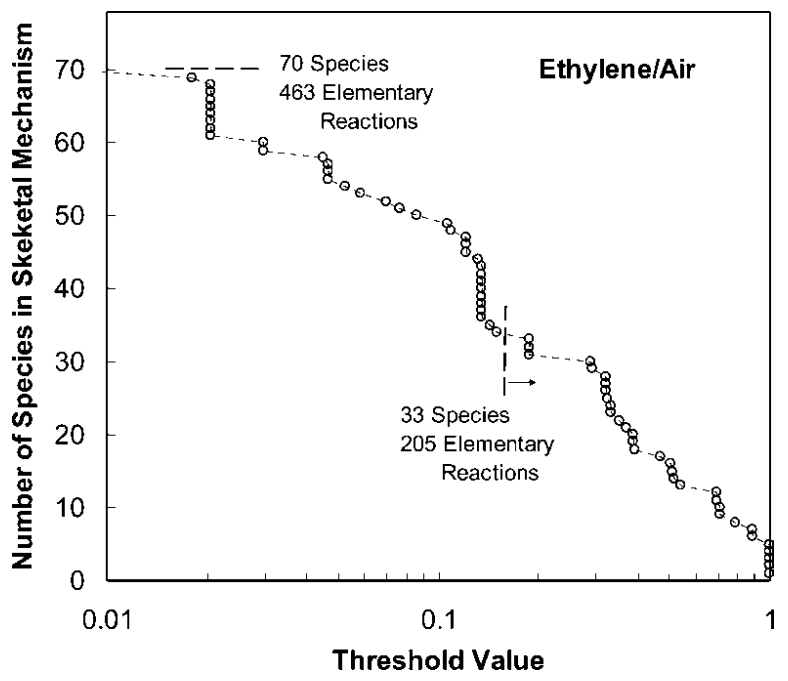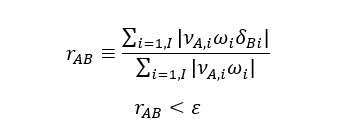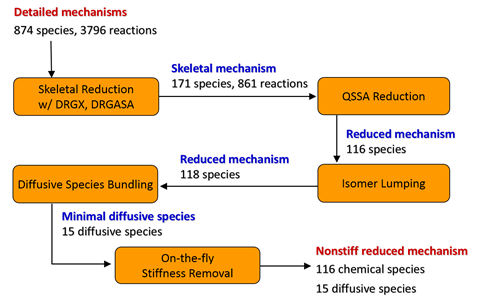Sound scientific understanding is necessary to develop predictive, validated multi-scale models for advanced engine simulations
Diverse fuel streams due to high oil price
- Heavy hydrocarbons
- Oil sands, oil shale, coal
- New renewable fuel sources
- Biofuels (ethanol etc), biodiesel
- Hydrogen fuel
- Natural gases
Advanced engine technologies (low-temperature combustion, LTC)
- Direct Injection (DI)
- Low-temperature combustion (LTC)
- Homogeneous Charge Compression Ignition (HCCI)
- HCCI-like combustion
- Mixed modes of combustion
- Lean, diluted, high-pressure, low-temperature
What is the HCCI engine?
Combine two types of the conventional internal combustion engines (Diesel + Gasoline engine)
- Lean homogeneous mixture
- Low pollutant emissions (NOx, soot, and etc)
- No fuel injector
- Low temperature combustion
- Compress Ignition
- Diesel-like compression ratios (>15)
- Higher efficiency that SI engines
- No fuel injector
- Hard to control ignition timing and duration of combustion
- Rapid change of heat release rate and pressure rise can damage the engine block
Schematic of current and future internal combustion engine concepts: Gasoline, Diesel, and HCCI engines (from Report of the Basic Energy Sciences Workshop on Basic Research Needs for Clean and Efficient Combustion of 21st Transportation Fuels, 2006, DOI: 10.2172/935428)
Operating regimes of traditional Spark-Ignited (SI) gasoline engines, Diesel engines, and novel low temperature combustion (LTC) devices which aim at creating conditions where the formation of soot and NOx is avoided ( J.E. Dec, Proc. Combust. Inst. 32 (2009) 2727-2742)
Advanced combustion concepts (HCCI-like combustion)
- HCCI with thermal stratification (TS)
- Spark-Assisted Compression Ignition (SACI)
- Stratified-Charge Compression Ignition (SCCI)
- Reactivity-controlled Compression Ignition (RCCI)

DNS of igntion of n-heptane/air mixture under HCCI conditions
- To elucidate the ignition characteristics of lean n-heptane/air mixture under high pressure (~ 40atm)
- n-heptane is a surrogate fuel for diesel
- 2D DNS with n-heptane/air reduced chemistry
- Turbulence/reaction interaction
- Competition between ignition delay and turbulent time-scale
- Temperature inhomogeneities
- Mean temperature and temperature RMS are important in determining overall ignition delay
- Mean temperature relative to the NTC (negative temperature coefficient) regime is the most important factor
Temporal evolution of mean heat release rate with different temperature RMS for (a) T0 = 850K, (b) 934 K, amd (c) 1008 K
DNS of igntion of iso-octane/air mixture under SACI conditions
- To elucidate the ignition characteristics of lean iso-octane/air mixture plus spark-ignition timing under SACI conditions
- New findings:
- Overall combustion enhances and HRR is more spread out with decreasing τs
- Early phase of combustion, deflagration is dominant
- After the occurrence of max. HRR, spontaneous ignition is dominant due to the remaining charge autoignition by compression heating
Temporal evolution of the mean HRR with different spark-ignition timing for Case 4—7
Contours of the normalized heat release rate for Case 4 (from left to right, normalized t = 0.52, 0.68, 0.77, and 0.78)
DNS of igntion of PRF/air mixture at a high temperature under HCCI conditions
- To elucidate the ignition characteristics of lean PRF/air mixture at a high temperature under HCCI conditions
- New findings:
- Small T′: spontaneous ignition is dominant, and the effect of fuel composition difference still remains in ignition
- Large T′: a mixed mode of deflagration and spontaneous ignition, and difference in fuel compositions has nearly no effect on ignitions of PRF HCCI combustion
- Ignition delay is highly sensitive with thermal stratification (TS)
Temporal evolution of the mean pressure and mean HRR with different temperature RMS at T0 = 1025 K for Case 1—9 .
Contours of the normalized heat release rate for Case 1—3 (from left to right, T′ = 15, 30, 60 K)
DNS of ignition of PRF/air mixture at an intermediate temperature under HCCI conditions
S.O. Kim, M.B. Luong, J.H. Chen, C.S. Yoo, “A DNS study of the ignition of lean PRF/air mixtures with temperature
inhomogeneities under high pressure and intermediate temperature”, Combust. Flame 162 (2015) 717–726,
http://dx.doi.org/10.1016/j.combustflame.2014.09.001
- To elucidate the ignition characteristics of lean PRF/air mixture at an intermediate temperature with different T’ and u’ under HCCI conditions
- New findings:
- Small-to-large T′: spontaneous ignition prevails for small T′ and the effect of fuel composition remains in ignition with a large T′
- Ignition delay is less sensitive with thermal stratification (TS) when T0 lies in/near the NTC regime
- Very large T′: difference in fuel compositions is significantly reduced with increasing T′, and turbulence with large u’ plus turbulence timescale greater than the shortest ignition delay can advance combustion overall by increasing turbulent flame area (case 8)
Temporal evolution of the mean pressure and mean HRR with different velocity RMS, u’ = 0.5 m/s and 2.5 m/s .
Contours of the normalized heat release rate for Case 3 (top) and Case 8 (bottom):
DNS of ignition of biodiesel/air mixture under SCCI conditions
M.B. Luong, T. Lu, S.H. Chung, C.S. Yoo, “Direct numerical simulations of ignition of a lean biodiesel/air mixture
with temperature and composition inhomogeneities”, Combust. Flame, (2014) 2878–2889,
http://dx.doi.org/10.1016/j.combustflame.2014.05.004
- To elucidate the ignition characteristics of lean biodiesel/air mixture with different turbulent intensity levels under SCCI conditions
- SCCI combustion concept:
- Using a two-stage-ignition fuel: a high-Φ sensitivity under low-temperature heat release (cool flame)
- Relying on a well-prepared mixture: (1) created appropriate Φ distribution by port fuel injection (PFI) and direct injection (DI), and (2) controlled by adjusting the PFI/DI fraction and DI timing
- SCCI is effective in controlling HRR
- New findings:
- Appropriate fuel distribution can control the ignition timing of HCCI combustion and provide a smooth HCCI operation under high load conditions
- A negatively-correlated T–Φ distribution field has an adverse effect on fuel stratification
- High turbulence intensity can effectively homogenize initial temperature and composition fluctuations such that the overall combustion is more apt to occur by spontaneous ignition for all the cases
Temporal evolution of the mean pressure and mean HRR with different T—Φ distribution correlations at T0 = 850 K for Case 1—12.
Contours of the normalized heat release rate for Case 1, 2, 8, and 12.
DNS of ignition of n-heptane/air mixture under SCCI conditions
M.B. Luong, G.H. Yu, T. Lu, S.H. Chung, C.S. Yoo, “Direct numerical simulations of ignition of a lean n-heptane/air
mixture with temperature and composition inhomogeneities relevant to HCCI and SCCI combustion”, Combust. Flame
(2015) 4566–4585, http://dx.doi.org/10.1016/j.combustflame.2015.09.015
- To elucidate the ignition characteristics of lean n-heptane/air mixture with different initial mean temperatures under SCCI conditions
- Three different initial mean temperatures were used: T0 = 805 K, 933 K, and 1025 K with the same ignition delay
- Three types of T—Φ distribution correlations: baselines (BL) cases with either T’ or Φ’, a negative correlation (NC) of and uncorrelated (UC) T—Φ distribution together with T’ of 15 K and 60 K, and Φ’ of 0.05 and 0.10 were selected
- The chemical aspects of the SCCI combustion were also investigated
- New findings:
- T0 lying in the NTC regime has positive effects on SCCI combustion by producing more deflagration, and thus reducing the HRR
- For low- and high-temperatures, a negatively-correlated T–Φ distribution field has adverse effect on fuel stratification
- T0 lying in the high temperature regime, thermal stratification (TS) is more effective in reducing HRR than fuel stratification (FS), whereas, fuel stratification does so with T0 lying in the low-to-intermediate temperature regime
- The most important species and reactions were identified using CEMA and agree with experimental studies
Temporal evolution of the mean HRR with different T—Φ distribution correlations at T0 = 805 K, 933 K, and 1025 K.
Schematic of reaction pathways of n-heptane oxidation at different temperatures
M.B. Luong, G.H. Yu, S.H. Chung, C.S. Yoo, “Ignition of a lean PRF/air mixture under RCCI/SCCI conditions:
Chemical aspects”, Proc. Combust. Inst., 36 (2017) 3587–3596, http://dx.doi.org/10.1016/j.proci.2016.06.076
Isocontours of PIs of controlling reactions for Case 16
DNS of ignition of PRF/air mixture under RCCI/SCCI conditions: a comparative study
M.B. Luong, G.H. Yu, S.H. Chung, C.S. Yoo, “Ignition of a lean PRF/air mixture under RCCI/SCCI conditions: A
comparative DNS study”, Proc. Combust. Inst., 36 (2017) 3623–3631, http://dx.doi.org/10.1016/j.proci.2016.08.038
- To elucidate the ignition characteristics of lean PRF/air mixture at different initial mean temperatures under RCCI conditions
- RCCI combustion concept
- Using two fuels with opposite ignition characteristics: highly reactive and less reactive fuels
- Relying on a well-prepared mixture: PFI of low reactivity fuel (iso-octane) and DI of high reactivity fuel (n-heptane)
- RCCI increases engine operating range and allow better controls of ignition timing and HRR by changing global fuel reactivity and variations in reactivity, equivalence ratio, and temperature
- SCCI combustion concept
- Similar to RCCI combustion, but a single fuel with two-stage ignition, PRF50, is used
- New findings:
- RCCI offers a better control of ignition delay and HRR over SCCI when T0 lies in the low-to-intermediate temperature regime
- Reactivity stratification plays a predominant role in reducing the rate of heat release and controlling ignition timing
- The overall combustion of both RCCI and SCCI is enhanced with T0 lying in the NTC regime
- However, T0 in the high-temperature regime has an adverse effect on the overall RCCI/SCCI combustion
- High turbulent intensity also has a detrimental effect on RCCI combustion, leading to a delayed combustion with a dominant spontaneous ignition mode

Temporal evolution of the mean pressure and mean HRR at (a) T0 = 800K, (b) 900 K, amd (c) 1000 K
Contours of the normalized heat release rate for Case 2, 4, 6, 8, 10, and 12.
Dual Fuel Engine Combustion
Environmental issues Today’s world is mainly relying on Compression Ignition engines for power generation, especially in the transport sector. Furthermore, compression ignition (CI) engines emit high levels of particulate matter (PM) and oxide of nitrogen (NOx) emissions due to combustion with heterogeneous air fuel mixture, which has forced us to concentrate on finding alternative to conventional petroleum fuels.
- Solution: gaseous fuels in addition to the liquid diesel in dual fuel engine
Alternative gaseous fuels
- e.g. LNG (CH4), LPG (C3H8, C4H10), ethane (C2H6), etc.
- Lowering the dependence on petroleum
- Reduce the emissions of CO2 and other pollutants from diesel engines
Dual-fuel engine Dual-fuel engine is the diesel engine that can run on both gaseous and liquid fuels. Typically, in a dual-fuel engine, gaseous fuel (main fuel) is supplied to the engine during suction stroke and diesel fuel (pilot fuel) is directly injected into the combustion chamber at the end of compression stroke to initiate the ignition. The advantage of Dual-fuel engine Potential advantages of dual-fuel engines include diesel-like efficiency and brake mean effective pressure (BMEP) with much lower emissions of oxides of nitrogen (NOx) and particulate matter. New technologies offer solutions to the problems of poor efficiency and emissions at light load. Dual-fuel engines can be designed to operate interchangeably on natural gas with a diesel pilot, or on 100% diesel fuel. 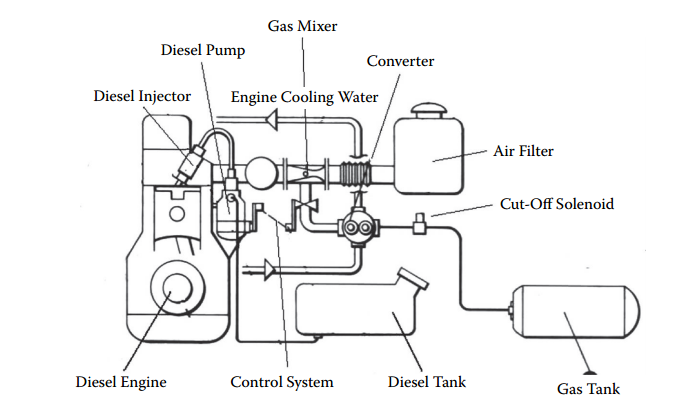
An example of dual-fuel engine installation with fumigated fuel gas. (Bergman, H., and Busenthur, B., Facts Concerning the Utilization of Gaseous Fuels in Heavy Duty Vehicles, in Proceedings of the Conference on Gaseous Fuels for Transportation, August 1986, pp. 813-849.)
Needs of fuel sharing mode combustion
- Require gas/diesel mixture detailed chemistry for engine simulations
- LNG & LPG/diesel detailed chemistry development
Develop LNG/diesel and LPG/diesel detailed chemistries
- Suitable chemistry mechanisms for using practical engine combustion simulations
- Mechanism reduction
- Develop skeletal mechanism of gas/diesel mixture
- Cost and time saving
- Suitable for 3-D practical engine simulation
- Simulations and experiments
- Comparison between gas/diesel fuel engine simulations and experiments
- Validation target chemistry mechanisms in engine operating conditions
Four-Stroke Dual-Fuel Engine (resource: Wartsila Corp.)
Detailed chemical mechanisms of LNG/diesel, LPG/diesel and H2/diesel
- Detailed mechanism predicts combustion behavior
- Ignition delay
- Flame propagation speed
- Limitation of detailed mechanism
- Huge computational cost and time
- Unsuitable 3-D CFD for practical engine simulations
- Suggestion
- Skeletal or reduced mechanism
- Suitable for 3-D CFD engine simulations
- Well prediction of combustion behavior and fuel characteristics
MECHANISM REDUCTION FOCUSING ON ENGINE SPECIFIC CONDITIONS Reduction of detailed mechanism to skeletal mechanism
- LNG: H2 & CH4 detailed mechanisms
- LPG: C3H8 & C4H10 detailed mechanisms
- Hydrogen: H2 detailed mechanism
- Diesel: Surrogate fuel n-dodecane (C12H26) and n-heptane (C7H16) are used
 A direct relation graph showing typical relations of the species
A direct relation graph showing typical relations of the species
Example of mechanism reduction (primary reference fuel)
ENGINE SIMULATION USING OPENFOAM Generation of simple geometry & coarse mesh  Moving mesh
Moving mesh 

P, T trace of PRF/air mixture in HCCI engine conditions
Run OpenFOAM simulation (parallel)
- Simulation platform
- OpenFOAM
- Open source CFD code
- Suitable for parallel computing
- Great expandability
- Simulation domain
- Compression heating dynamic engine domain
- Suitable turbulent modeling for describe turbulence in engine cylinder
MODIFICATION OF THE MECHANISM Sensitivity analysis and tuning
- Arrhenius law
- Doubling the rate constant of the ith reaction to identify the Sensitivity coefficient(SC)
- Reactions with the largest magnitude of SC are selected
Positive SC means deceleration of ignition, and longer ignition delay Negative SC means acceleration of ignition, and shorter ignition delay
- comparing with engine experiments
- Collect experimental data
- Generate detail geometry & fine mesh
- Comparison between experimental and simulation data
- Iterative modification of mechanism
